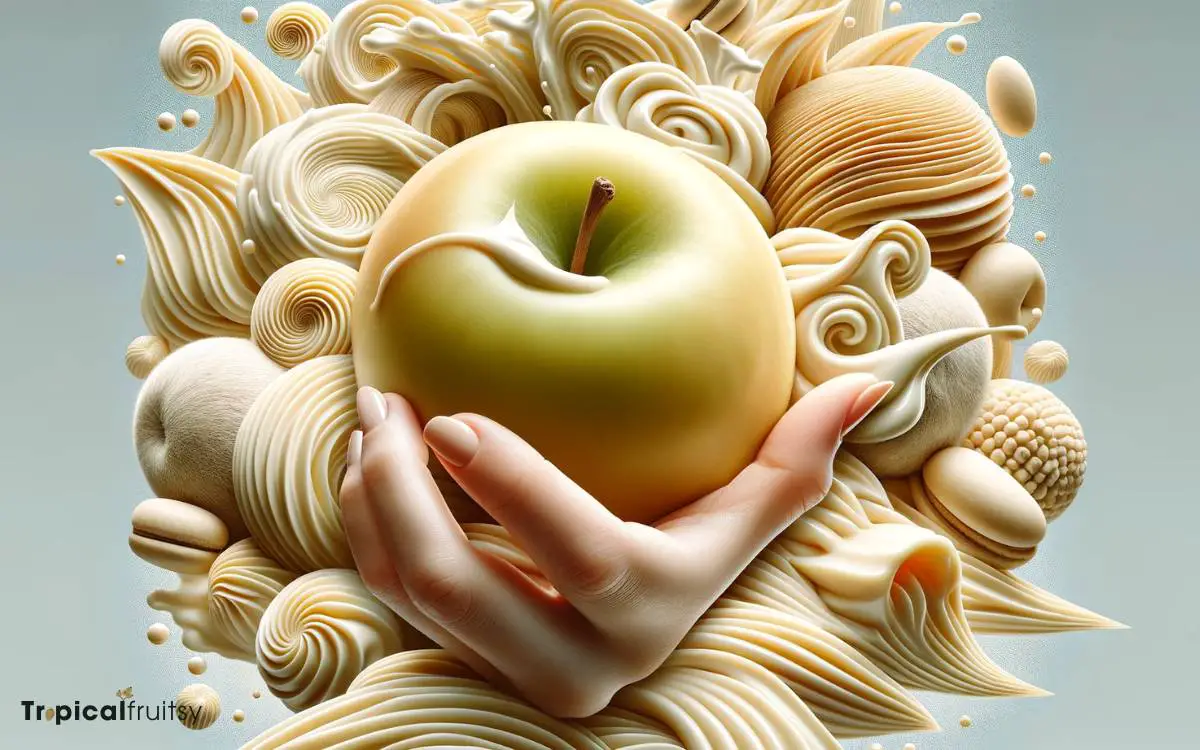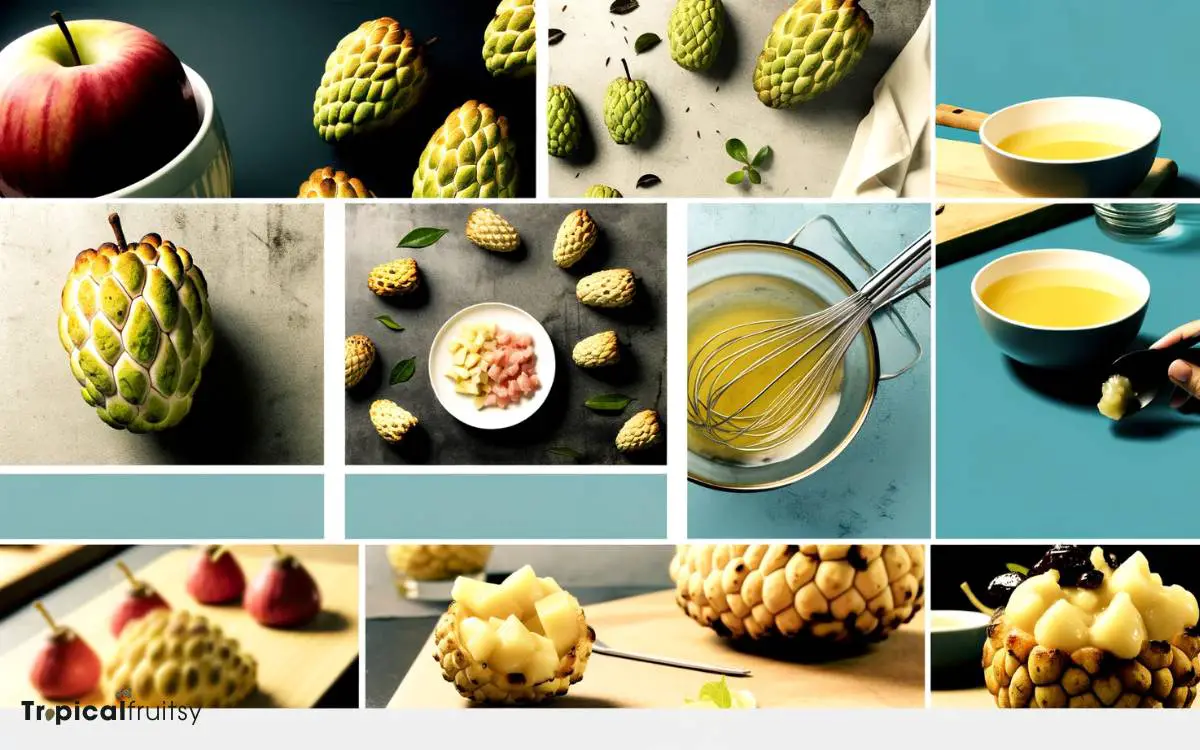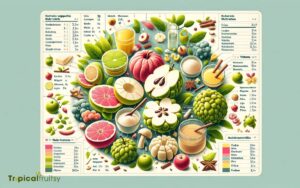What Does Custard Apple Taste Like: Flavorful Delight!
Custard apple, also known as cherimoya, is a tropical fruit with a sweet taste that resembles a blend of various fruits.
It has a creamy, custard-like texture and a unique flavor profile combining notes of banana, pineapple, and a subtle hint of vanilla.
The taste of custard apple is often described as a mix of other fruits, which makes it quite distinctive:
The texture is soft and creamy, similar to traditional custard, hence the name. The sweetness level can vary depending on the fruit’s ripeness, from mildly sweet to very sugary, much like candy.
Discover the exotic blend of banana, pineapple, and vanilla flavors in the creamy delight of a custard apple.

Key Takeaway
Explore the Taste of Custard Apple: A Creamy Tropical Delight
| Aspect | Description |
|---|---|
| Flavor Profile | Banana, pineapple, vanilla |
| Texture | Creamy, custard-like, sometimes granular |
| Sweetness | Ranges from subtly sweet to very sweet |
| Aroma | Fragrant with a hint of vanilla |
| Ripeness Impact | Sweeter and softer as it ripens |
| Common Names | Custard apple, cherimoya, sugar apple, sweetsop |
| Nutritional Value | High in vitamin C, fiber, and antioxidants |
Unveiling the Custard Apple

During my first encounter with a custard apple, I was struck by its unique, heart-shaped form and the textured, green skin that hinted at the tropical origins of this fruit.
The gentle give under my fingers suggested a ripe, creamy interior. Cutting into the custard apple revealed flesh that was remarkably soft, almost like a ripe cheese interspersed with dark, glossy seeds.
The aroma was sweet and earthy, with a hint of floral notes that intrigued my senses. I analyzed its composition, recognizing that this delicacy’s structure promised a dessert-like experience.
As I took the first bite, the flavors confirmed my suspicions – a rich, custardy taste that was both luscious and satisfying.
The Sweetness Spectrum

As I explore the custard apple’s taste, I’m struck by its natural sugar content, which is at the heart of its sweetness spectrum.
By analyzing and comparing its flavor with other fruits, we can better grasp where it stands in terms of sugary indulgence.
The degree of ripeness is crucial too; it can significantly alter the fruit’s sweetness, making this an essential point of consideration for any custard apple enthusiast.
Natural Sugar Levels
I’ve noticed that the natural sugar levels in custard apples place them high on the sweetness spectrum, often making them a delightful treat for those with a sweet tooth. The luscious fruit packs a sugary punch that’s both enticing and satisfying.
Here’s a snapshot of its sugary profile:
- Naturally high in fructose: The sweetness hits quickly, providing an immediate pleasure.
- Contains glucose: Offers sustained energy, preventing a rapid sugar crash.
- Balanced with fiber: Slows sugar absorption, promoting a steadier blood sugar level.
- Rich in antioxidants: Adds to its health appeal, despite its sweetness.
- Vitamin C content: A sweet bonus, enhancing nutritional value.
Analyzing its sugar composition, it’s clear that a custard apple is a wholesome sweet indulgence.
Flavor Comparison Chart
I’ll present a flavor comparison chart below, where the custard apple’s sweetness is measured against five other fruits to give you a clear sense of where it stands on the sweetness spectrum.
Imagine a line where at one end, you have the subtly sweet taste of a fresh fig, and at the other, the bold sugariness of a ripe mango.
The custard apple falls closer to the mango, with a rich sweetness that’s tempered by a slightly tart undercurrent.
It’s more saccharine than a banana but not as intense as a date. In contrast, the kiwi and the berry sit at the less sweet end, with their tangy notes.
Understanding this spectrum is crucial because sweetness in fruit isn’t simply a matter of sugar content; it’s about the balance of flavors.
Ripeness Impact
The custard apple’s flavor profile undergoes a remarkable transformation as it ripens, shifting from a tangy tartness to a luscious sweetness that I find utterly captivating.
Let me paint you a picture of this sweetness spectrum:
- Slightly underripe: A zestier, almost lemony undertone that’s refreshing.
- Just ripe enough: The emergence of a balanced sweetness with subtle sour notes.
- Perfectly ripe: A rich, honeyed flavor that’s both deep and complex.
- Overripe: Intense sweetness that can verge on cloying, with tropical fruit hints.
- Far too ripe: A fermented, wine-like taste that mightn’t be everyone’s cup of tea.
With each stage of ripeness, the custard apple offers a unique tasting experience. Understanding this spectrum will guide you to your preferred sweetness level.
Texture and Mouthfeel

As I savor a custard apple, its creamy consistency is immediately striking, enveloping my palate with a velvety richness that’s truly indulgent.
Yet, amidst this softness, the presence of grainy seeds creates a contrasting texture that adds an unexpected dimension to the experience.
I’m convinced that this interplay between creamy and grainy textures not only heightens the fruit’s appeal but also sets it apart from its smooth-skinned relatives.
Creamy Consistency
Upon first bite, I’m struck by the custard apple’s remarkably smooth and creamy texture that fills the mouth with a rich, velvety sensation.
The experience is akin to indulging in a luxurious dessert that’s both satisfying and refreshing. As I analyze the fruit’s consistency further, I can’t help but be persuaded of its unique charm.
- Butter-like richness: Comparable to the finest pats of butter melting effortlessly on the palate.
- Silken feel: As if savoring a spoonful of premium custard or crème brûlée.
- Pudding-like softness: Delicately yielding to the slightest pressure.
- Mousse-like fluffiness: Airy yet substantial, providing an exquisite balance.
- Satisfying creaminess: Leaves a pleasant, lingering coat reminiscent of full-fat cream.
This texture is essential in differentiating custard apple from other fruits, offering a gourmet experience that’s truly unrivaled.
Grainy Seed Texture
While the flesh of the custard apple is undeniably smooth, I’m immediately aware of the contrasting grainy texture of the embedded seeds as they brush against my tongue.
This juxtaposition is striking – the creaminess of the fruit is almost luxurious, yet the seeds introduce a disruptive element to the experience.
It’s worth noting that these seeds aren’t meant to be eaten; they’re hard and can be unpleasant if bitten into. I find that the best approach is to gently maneuver them aside with my tongue, savoring the lush fruit while avoiding the seeds.
This technique enhances the enjoyment of the custard apple’s unique flavor profile and allows for an uninterrupted appreciation of its velvety texture without the interference of the seeds’ grittiness.
Flavor Profile Nuances

I’ve noticed that one’s first taste of custard apple often reveals a complex blend of sweet and tangy flavors with subtle hints of tropical fruit.
This multifaceted taste sensation can be broken down as follows:
- Richness: A creamy, custard-like decadence that coats the palate.
- Sweetness: Reminiscent of sugary notes found in ripe pears or a hint of honey.
- Tanginess: A slight sharpness that adds a refreshing contrast to the sweetness.
- Exotic Spices: Traces of nutmeg or vanilla that give a warm, aromatic complexity.
- Tropical Essence: Underlying flavors that might remind you of banana or pineapple.
Delving into these nuances, I’m convinced that custard apple’s flavor is truly unique. Its taste intricacies beg a further investigation into how ripeness influences these delightful variances.
Ripeness and Taste Variation

In light of the flavor complexities just described, I’ll now explore how the ripeness of a custard apple can significantly alter its taste profile.
When it’s not fully ripe, a custard apple may taste tart and slightly astringent, with the creaminess less pronounced.
As it ripens, the flesh softens and the flavor becomes deeply sweet with richer tropical notes, enhancing its custard-like quality. The sugars develop, and the acidity mellows, creating a balance that’s both luscious and nuanced.
It’s crucial to taste the fruit at different stages to appreciate the full spectrum of its flavors. Overripeness, however, can lead to a fermented aftertaste, which some might find unpleasant.
Pairing and Culinary Uses

Now that we’ve examined how ripeness affects flavor, I’ll share how to best pair a custard apple in both sweet and savory dishes.
The creamy texture and unique taste of custard apple can elevate a dish, offering a tropical nuance that’s hard to match.
Here’s how you can incorporate this delightful fruit:
- Blend it into smoothies for a rich, custard-like thickness.
- Mix into yogurt or oatmeal, balancing its sweetness with tart berries.
- Create exotic salads by adding it to spinach, nuts, and a tangy vinaigrette.
- Puree it into sauces or chutneys to accompany grilled meats.
- Bake it into pastries or custards, where its flavor truly shines.
Conclusion
In the orchard of flavors, the custard apple reigns supreme with its creamy sweetness, akin to a ballet of tropical notes on my tongue.
Its velvety texture and nuanced taste, which transforms as it ripens, invite endless culinary adventures.
Whether paired with other ingredients or savored solo, this fruit never fails to seduce the palate.
Trust me, one bite and you’ll be under its spell, eager to explore all the delicious possibilities it has to offer.






